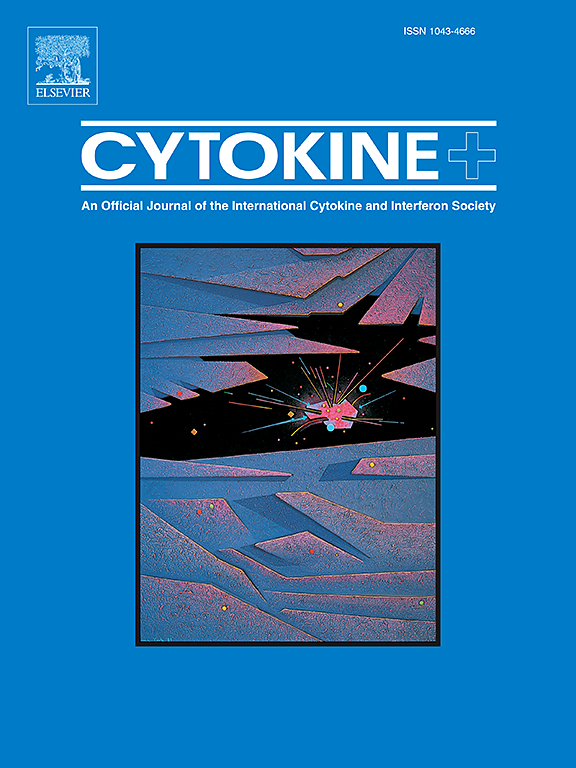Chemerin, TNF − α and the degree of albuminuria in patients with diabetic kidney disease
IF 3.7
3区 医学
Q2 BIOCHEMISTRY & MOLECULAR BIOLOGY
引用次数: 0
Abstract
Background
Chronic inflammation has been increasingly recognized as an essential pathogenic mechanism for the development and progression of diabetic kidney disease (DKD). Chemerin is an adipokine which has been suggested to be related to inflammation and has been correlated with the development of diabetic complications. We aimed to explore the potential links between chemerin, TNF – α, as a marker of systemic inflammation, and the level of albuminuria in patients with type 2 diabetes mellitus (T2DM).
Method
The study included 84 patients with T2DM and 10 normoalbuminuric non-diabetic controls. Demographic, clinical and laboratory data including chemerin and TNF-α levels were collected.
Results
A total of 84 diabetic patients were enrolled, 32 males (38.1 %), with mean age 57.9 ± 10.7 years. They were divided into 3 groups: A1: 14 with normalbuminuria, A2: 27 with microalbuminuria, and A3: 43 with macroalbuminuria (uACR < 30, 30–300 and > 300 mg/gm respectively). Chemerin and TNF-α levels increased with the progress of albuminuria (control: 21.3 (14.7 –77), A1: 794 (683–925), A2: 1150 (962.9 – 1221.5) and A3: 1466 (1197.5 – 2002.5) ng/ml; p < 0.001) and (control: 77.9 (59 – 96.8), A1: 85.2 (71–116.3), A2: 87.3 (81 – 97.5) and A3: 99 (85.1 – 142.5) pg/ml; p = 0.009) respectively. Among the diabetics, a significant association was evident between serum chemerin and serum TNF-α (r = 0.53; p < 0.001). On linear stepwise regression analysis, chemerin was significantly associated with TNF-α and HbA1c (unstandardized β 10.881 and 272.68 respectively, p < 0.001); and TNF-α was significantly correlated with chemerin, uACR (unstandardized β 0.059 and 0.004 respectively, p < 0.001) and HbA1c (unstandardized β −13.699, p = 0.014).
Conclusion
Our findings suggest a potential role of chemerin and TNF-α in the development and progression of DKD, and thus support the role of the inflammatory pathway. Larger follow up studies are warranted to further explore the potential links between chemerin, inflammation and DKD.
糖尿病肾病患者的螯合素、TNF - α和白蛋白尿程度。
背景:人们日益认识到,慢性炎症是糖尿病肾病(DKD)发生和发展的重要致病机制。螯合素是一种脂肪因子,被认为与炎症有关,并与糖尿病并发症的发生相关。我们旨在探讨螯合素、作为全身炎症标志物的 TNF - α 与 2 型糖尿病(T2DM)患者白蛋白尿水平之间的潜在联系:研究对象包括 84 名 T2DM 患者和 10 名正常白蛋白尿非糖尿病对照者。收集了人口统计学、临床和实验室数据,包括螯合素和 TNF-α 水平:共招募了 84 名糖尿病患者,其中 32 名男性(38.1%),平均年龄(57.9±10.7)岁。他们被分为 3 组:A1:14 例白蛋白尿正常;A2:27 例微量白蛋白尿;A3:43 例大量白蛋白尿(uACR 分别为 300 mg/gm)。螯合素和 TNF-α 的水平随着白蛋白尿的增加而增加(对照组:21.3(14.7 -77),A1:794(683-925),A2:1150(962.9 - 1221.5)和 A3:1466(1197.5 - 2002.5)纳克/毫升;P 结论:我们的研究结果表明,螯合素和 TNF-α 在白蛋白尿中具有潜在的作用:我们的研究结果表明,螯合素和 TNF-α 在 DKD 的发生和发展过程中可能发挥作用,因此支持炎症通路的作用。有必要进行更大规模的后续研究,以进一步探讨螯合素、炎症和DKD之间的潜在联系。
本文章由计算机程序翻译,如有差异,请以英文原文为准。
求助全文
约1分钟内获得全文
求助全文
来源期刊

Cytokine
医学-免疫学
CiteScore
7.60
自引率
2.60%
发文量
262
审稿时长
48 days
期刊介绍:
The journal Cytokine has an open access mirror journal Cytokine: X, sharing the same aims and scope, editorial team, submission system and rigorous peer review.
* Devoted exclusively to the study of the molecular biology, genetics, biochemistry, immunology, genome-wide association studies, pathobiology, diagnostic and clinical applications of all known interleukins, hematopoietic factors, growth factors, cytotoxins, interferons, new cytokines, and chemokines, Cytokine provides comprehensive coverage of cytokines and their mechanisms of actions, 12 times a year by publishing original high quality refereed scientific papers from prominent investigators in both the academic and industrial sectors.
We will publish 3 major types of manuscripts:
1) Original manuscripts describing research results.
2) Basic and clinical reviews describing cytokine actions and regulation.
3) Short commentaries/perspectives on recently published aspects of cytokines, pathogenesis and clinical results.
 求助内容:
求助内容: 应助结果提醒方式:
应助结果提醒方式:


